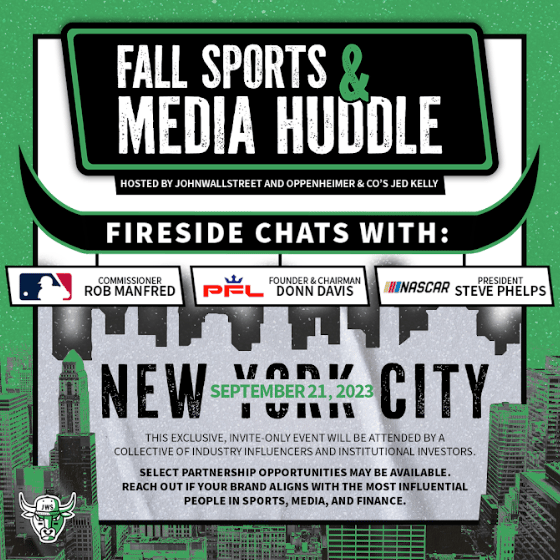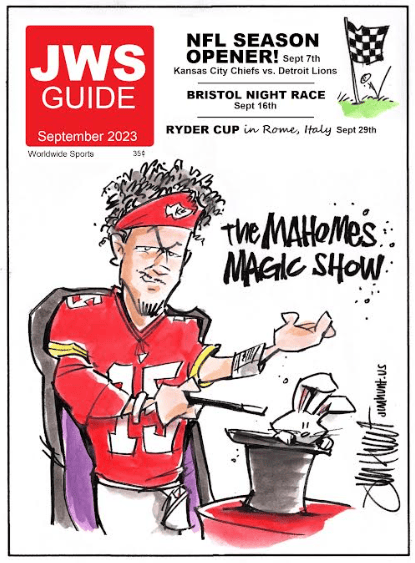- JohnWallStreet
- Posts
- Disney-Charter Standoff Unlikely to Destroy Pay TV Ecosystem, But Will Leave Lasting Impact
Disney-Charter Standoff Unlikely to Destroy Pay TV Ecosystem, But Will Leave Lasting Impact

Disney-Charter Standoff Unlikely to Destroy Pay TV Ecosystem, But Will Leave Lasting Impact

The Walt Disney Company channels remain blacked out on Charter Spectrum cable systems. The ongoing carriage dispute threatens to leave some portion of nearly 15 million people without access to Aaron Rodgers’ New York debut. Tonight’s game is going to be broadcast by ESPN and simulcast on ABC.
“It’s definitely a seminal day [in the negotiations],” Bob Thompson (former president, Fox Sports Networks) said.
While the two sides may appear to be far apart in negotiations, both should be motivated to work through their differences–if not necessarily in time for kickoff of Jets-Bills.
“If Disney loses Charter, it probably loses everybody [within reason]; or at the very least, sees its terms with other Pay TV distributors altered over time [as those entities will leverage their perceived increase in value to Disney in future negotiations],” media consultant Patrick Crakes said.
And Charter knows its lucrative broadband service is sold most effectively when bundled together with other products and/or services.
So, the now weeklong standoff doesn’t seem likely to spur the feared apocalypse. But this negotiation is likely to leave a lasting impact on the sports media business.
“Charter doesn’t go to the mat on this like they have otherwise,” Thompson said.
One change will come in rights owner economics.
“We’re entering a new era of content spend where the [leagues] with the most value become even more valuable,” Crakes said, “most likely at the expense of other properties.”
Another change is likely to come in the flexibility distributors have in packaging video content.
Charter wants to strip “a lot of these expensive channels out of the bundle and sell skinny bundle packages with them and [Disney’s] direct-to-consumer offerings; and then pay a discounted rate to the programmer,” Thompson said.
That would enable it to participate in the upside Disney has in self-distributing its own content.
Of course, those new skinny bundles could/would be paired with broadband and other services.
SPONSORED BY VISION INSIGHTS
Playfly Sports has released brand new MLB insights in its new report: Playfly Fan Score: MLB Edition powered by Vision Insights.
For example, did you know Major League Baseball viewing is predominantly local. Local MLB broadcasts make up 82% of all regular season viewing. As the MLB pennant races start heating up, Playfly has uncovered many more insights about MLB Fandom.
According to Forbes: “The Playfly Sports report, working with Vision Insights, is a valuable view into the under told story of Major League Baseball as valuable advertising sports property.”

Playfly Fan Score ranks teams based on 12 proprietary algorithms developed by the internal team of data scientists and the team at Vision Insights. All leading to a fresh perspective to understanding fandom including: Fan Passion, Fan Receptivity, Fan Marketplace.
Playfly Sports Consulting can help you with your team or brand needs.

Disney has not publicly stated all it is looking for.
“We know it is asking for a 10%+ bump on ESPN's subscriber fee, something more than an incremental dollar per sub; which is a lot. Most Pay TV channels don't even get one dollar,” Crakes said.
The problem is the pay TV bundle lost its natural monopolistic characteristics with the emergence of streaming alternatives a half decade ago. And the reality is the business today simply isn’t as good as it once was.
“The new system is segmented at best, and it has all these expenses that are tied to general market revenues, including content costs, laid directly against it. And those content costs are rooted in the old bundle that reached 90% of all U.S. TV homes,” Crakes said.
So, Charter doesn’t want to pay the increase sought.
Charter seeks to reimagine its deal with Disney based on this new reality, and a declining Pay TV universe of ~70 million homes. The company is looking for the flexibility to package Disney’s costly cable channels, and DTC streaming services, which it currently has no access or ability to offer, as it sees fit.
That doesn’t necessarily mean the company has plans to tier ESPN, at least not imminently. Heavy ESPN viewers remain the bundle's best customers. Losing those individuals would come with a cost to the distributor.
Charter’s goal is to maintain legacy subscribers while increasing its appeal amongst cord cutters/cord nevers with a reimagined bundle.
The distributor feels it should be allowed to market Disney’s streaming services within these products because “in some way, shape, or form [it] is subsidizing the programming on those channels by paying for the linear networks,” Thompson said.
But it seems unlikely that this impasse is the one that destroys the existing media ecosystem. Charter and Disney each have much to gain by evolving their relationship.
Without Disney Charter becomes less diverse, likely less profitable (even if margins rise), and its road to growth becomes harder.
And “if they somehow blow each other up, you have this [~$300 million/mo.] revenue hole for ESPN,” Crakes said. “Advertising only makes ~30% of company revenues. Where do the economics [and eyeballs] come from to replace that?”
So, it makes sense for Disney to do its part to preserve a profitable system, one likely capable of paying the bills and providing the broadest reach over the next decade too.
The question is how much will it cost them to maintain it?
Most favored nation clauses are going to force Disney to adjust its deals with other distributors in the wake of these negotiations.
That is ultimately where the rubber meets the road.
“It’s not about paying the bills today. It’s about paying the bills in five years,” Crakes said.
Remember, long-term deals with escalators keep sports content costs rising.
While entertainment content costs have started to come down in response to the changing distribution landscape, there hasn’t been much of that in sports to date. But if there is less revenue coming into broadcasters and contractual obligations continue to increase, eventually there is going to be less money to spend on new rights deals.
And the money left will increasingly flow to the properties at the top of the value pyramid.
“We just did a college football realignment that killed a conference largely because of this phenomenon, to concentrate the content even more for the new reality of this smaller bundle,” Crakes said.
Of course, the recent realignment moves were all made under the presumption the established Pay TV bundle will still exist through College Football Playoff expansion. P5 conferences banking on future rights increases to fund this growth ought to be rooting for Disney and Charter to work out their differences.
Assuming they do and the existing system survives, the top sports properties should be able to keep their economics intact (or climbing). But challenger and emerging leagues need to start preparing for the day when their route to traditional Pay TV revenues become more complicated.
“There just isn’t room for everyone anymore,” Crakes said.
Programmers are all but certain to become more selective with where they spend their dollars. The only question is when does the process begin.


Top 5 Sports Business Headlines
Click here to subscribe to Sport & Story Daily, the sports industry’s tip sheet..
🦁 NBC roars as Lions’ win lands 27 million viewers
📈 NWSL scores all-time best attendance record as league looks to expand
🚨 Spain federation president Rubiales resigns amid kiss fallout
🎾 AXS TV to air 2023 Major League Pickleball season 2 live events
🏝 Virgin Islands make big play with Cubs

